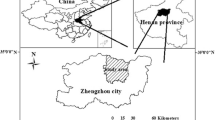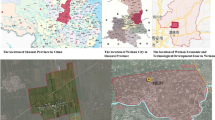Abstract
At the same time as the rapid development of developing countries, unreasonable conventional planning and industrialization have led to instability in rural areas, especially resource-based rural systems. Rural environment and planning continue to receive widespread attention. Based on the emergy analysis theory, this paper constructed a rural environmental value-added evaluation system with resource, development, space and environmental protection as the factor layer (including 18 sub-indicators). Based on this system, the value-added situation of the socio-economic-natural composite ecological environment of Queshan Village in Shanxi Province from 2010 to 2015 was quantitatively evaluated, and the development strategy was proposed. It was found that from 2010 to 2015, the resource element decreased from 0.17 to about 0.00, the development factor decreased from 0.16 to 0.06, the space factor increased by 0.19 from 0.07, the environmental protection factor decreased from 0.21 to 0.05, and the composite index decreased from 0.61 to 0.30. It showed that the ecological environment growth of Queshan Village was negative in the evaluation period, and the development showed an imbalance law and an unsustainable development trend. According to the analysis results, this paper put forward development opinions from four aspects: resources, industry, environment and government investment. This method constructs a quantitative analysis system for rural environmental value-added evaluation, and has certain theoretical and practical value in rural planning guidance and evaluation.











Similar content being viewed by others
References
Ali, M., Marvuglia, A., & Geng, Y. (2019). Accounting emergy-based sustainability of crops production in India and Pakistan over first decade of the 21st century. Journal of Cleaner Production, 207, 111–122.
Amaral, L. P., Martins, N., & Gouveia, J. B. (2016). A review of emergy theory, its application and latest developments. Renewable and Sustainable Energy Reviews, 54, 882–888.
Angilella, S., Catalfo, P., Corrente, S., et al. (2018). Robust sustainable development assessment with composite indices aggregating interacting dimensions, the hierarchical-SMAA-Choquet integral approach. Knowledge-Based Systems, 158, 136–153.
Babcicky, P. (2013). Rethinking the foundations of sustainability measurement, the limitations of the environmental sustainability index (ESI). Social Indicators Research, 113(1), 133–157.
Bagstad, K. J., Semmens, D. J., Waage, S., & Winthrop, R. (2013). A comparative assessment of decision-support tools for ecosystem services quantification and valuation. Ecosystem Services, 5, 27–39.
Chang, T., Yang, D., Huo, J., et al. (2018). Evaluation of Oasis sustainability based on emergy and decomposition analysis. Sustainability-Basel, 10(6), 1856.
Chen, W., Shen, Y., & Wang, Y. (2018). Evaluation of economic transformation and upgrading of resource-based cities in Shaanxi province based on an improved TOPSIS method. Sustainable Cities and Society, 37, 232–240.
Cheng, C., & Cheng, K. (2018). Evaluation of the sustainability of Hakka villages in the Lui-Tui area of Taiwan via emergy analysis. Environment, Development and Sustainability, 20(6), 2831–2856.
Dang, X., Liu, G., Xue, S., & Li, P. (2013). An ecological footprint and emergy based assessment of an ecological restoration program in the Loess Hilly Region of China. Ecological Engineering, 61, 258–267.
Fan, Y., Qi, Q., Xian, C., et al. (2017). A modified ecological footprint method to evaluate environmental impacts of industrial parks. Resources, Conservation and Recycling, 125, 293–299.
Ferraro, D. O., & Benzi, P. (2015). A long-term sustainability assessment of an Argentinian agricultural system based on emergy synthesis. Ecological Modelling, 306(6), 121–129.
Graymore, M. L. M., Sipe, N. G., & Rickson, R. E. (2010). Sustaining human carrying capacity, a tool for regional sustainability assessment. Ecological Economics, 69(3), 459–468.
Greenberg, P. (2017). Disproportionality and resource-based environmental inequality, an analysis of neighborhood proximity to coal impoundments in Appalachia. Rural Sociology, 82(1), 149–178.
Guan, X., Chen, M., & Hu, C. (2015). An ecological compensation standard based on emergy theory for the Xiao Honghe River Basin. Water Science and Technology, 71(10), 1463–1470.
Han, H., Zhong, Z., Wen, C., & Sun, H. (2018). Agricultural environmental total factor productivity in China under technological heterogeneity, characteristics and determinants. Environmental Science and Pollution Research, 25(32), 32096–32111.
Jafari, M., Asgharipour, M. R., Ramroudi, M., et al. (2018). Sustainability assessment of date and pistachio agricultural systems using energy, emergy and economic approaches. Journal of Cleaner Production, 193, 642–651.
Lacarrière, B., Deutz, K. R., Jamali-Zghal, N., & Le, C. O. (2015). Emergy assessment of the benefits of closed-loop recycling accounting for material losses. Ecological Modelling, 315, 77–87.
Lan, S., Qin, P., Lu, H. (2002). Emergy analysis of eco-economic system. Beijing: Chemical Industry Press.
Li, Y. U., Yanyu, L. U., Wei, H., & Yuqing, X. U. (2016). The significance and general approaches of climatic carrying capacity assessment. Chinese Journal of Urban & Environmental Studies, 04(01), 1650005.
Liu, C., Shi, X., Qu, L., & Li, B. (2016). Comparative analysis for the urban metabolic differences of two types of cities in the resource-dependent region based on emergy theory. Sustainability-Basel, 8(7), 635.
Lu, D. (2017). Research on Wuxi ecosystem health assessment based on emergy analysis. Nanjing: Nanjing University.
Mainali, B., Pachauri, S., Rao, N. D., & Silveira, S. (2014). Assessing rural energy sustainability in developing countries. Energy for Sustainable Development, 19(1), 15–28.
Mori, K., & Christodoulou, A. (2012). Review of sustainability indices and indicators, towards a new City Sustainability Index (CSI). Environmental Impact Assessment, 32(1), 94–106.
Odum, H. T. (1996). Environmental accounting—emergy and environmental decision making. Child Development, 42(4), 1187–1201.
Pan, H., Zhang, X., Wu, J., et al. (2015). Sustainability evaluation of a steel production system in China based on emergy. Journal of Cleaner Production, 112, 1498–1509.
Pang, M., Zhang, L., Ulgiati, S., & Wang, C. (2015). Ecological impacts of small hydropower in China, Insights from an emergy analysis of a case plant. Energ Policy, 76, 112–122.
Qu, L., Shi, X., Liu, C., & Yuan, Y. (2017). An emergy-based hybrid method for assessing sustainability of the resource-dependent region. Sustainability-Basel, 9(1), 153.
Ruckelshaus, M., Mckenzie, E., Tallis, H., et al. (2015). Notes from the field, lessons learned from using ecosystem service approaches to inform real-world decisions. Ecological Economics, 115, 11–21.
Siche, J. R., Agostinho, F., Ortega, E., & Romeiro, A. (2008). Sustainability of nations by indices, comparative study between environmental sustainability index, ecological footprint and the emergy performance indices. Ecological Economics, 66(4), 628–637.
Wang, R. (2009). Dynamic analysis of agro-ecosystem in Shanxi Province based on emergy. Changsha: Hunan Agricultural University.
Wang, R. (2016). Construction and empirical study on evaluation index system of provincial ecological civilization in China. Beijing: China University of Geosciences.
Yang, Q., Chen, G. Q., et al. (2013). Environmental sustainability of wind power, An emergy analysis of a Chinese wind farm. Renew Sust Energ Rev, 25(5), 229–239.
Yang, S. (2017). A case study of a novel sustainable agricultural development evaluation method based on Euclidean distance theory. Acta Ecologica Sinica, 37(11), 3840–3848.
Yang, X. (2016). Research on the development model of resource-based rural transformation. Jinzhong: Shanxi Agricultural University.
Yi, H., Srinivasan, R. S., Braham, W. W., & Tilley, D. R. (2017). An ecological understanding of net-zero energy building, evaluation of sustainability based on emergy theory. Journal of Cleaner Production, 143, 654–671.
Yue, J., Jiang, X., Yuan, X., et al. (2017). Design of a multiplexed system for domestic wastewater of Happy Farmer’s Home (HFH) and environmental evaluation using the emergy analysis. Journal of Cleaner Production, 156, 729–740.
Zhou, M. M. (2011). Environmental injustice in China’s industrialized rural areas, observations from Juancheng county and their national context. Berkeley Undergraduate Journal, 24(3), 149–159.
Zulaica, L., & Tomadoni, M. (2015). Environmental sustainability indicators in the periurban of Mar del Plata City, Argentina. Anales de Geografia de la Universidad Complutense, 35(2), 195–216.
Acknowledgements
This study was sponsored by Pingding County Government.
Author information
Authors and Affiliations
Corresponding author
Additional information
Publisher's Note
Springer Nature remains neutral with regard to jurisdictional claims in published maps and institutional affiliations.
Rights and permissions
About this article
Cite this article
Wan, A., Tu, R., Yue, W. et al. Construction and case study of rural environmental value-added evaluation system based on emergy theory. Environ Dev Sustain 23, 4715–4734 (2021). https://doi.org/10.1007/s10668-020-00729-7
Received:
Accepted:
Published:
Issue Date:
DOI: https://doi.org/10.1007/s10668-020-00729-7




